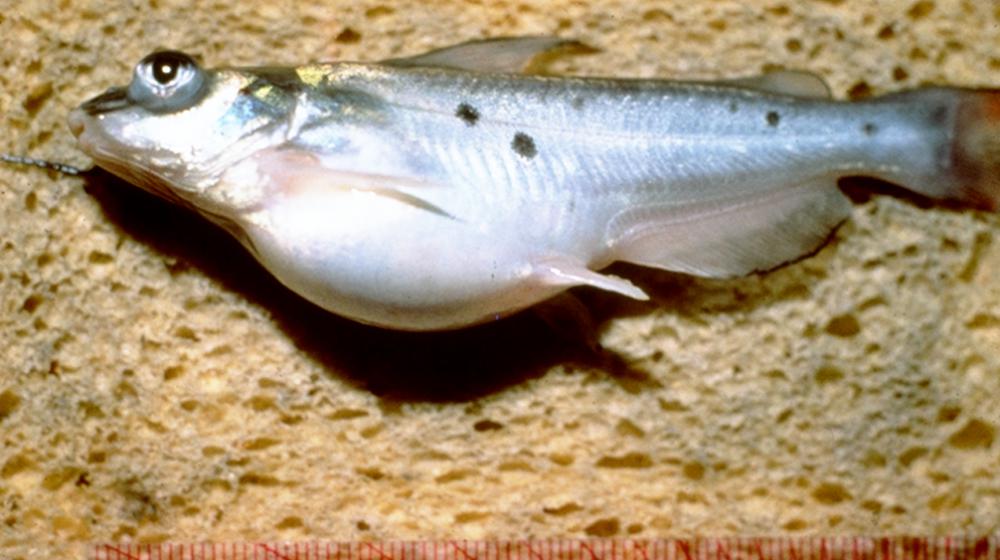Diseases
The "low-intensity" management practices used prior to the 1980's generally resulted in good pond water quality and lower overall stress on fish populations. Lower fish densities also meant less efficient transmission of disease organisms. Over the years, stocking and feeding rates steadily increased and producers adopted a multiple-batch cropping system wherein new populations of fingerlings were stocked into ponds with existing populations of larger fish. These production practices lead to the emergence of infectious diseases as the primary limiting factor in catfish production, and disease outbreaks are not uncommon even on well-run facilities.
Economic losses resulting from infectious diseases are difficult to quantify because record keeping varies among farmers and many diseases go unreported. Nevertheless, infectious disease is believed to cost producers many millions of dollars in direct fish losses each year. In addition, infectious diseases influence profitability by increasing treatment costs, reducing food consumption by fish, increasing feed conversion ratios, and causing harvesting delays. Fish-eating birds may also be attracted to ponds with sick and dying fish causing further losses.
Once a disease outbreak occurs, effective health management requires three basic steps: problem identification, diagnosis, and corrective management--all of which must be performed in a timely manner to avoid further losses. Whenever multiple factors contribute to the disease process, it makes the diagnosis more difficult and often complicates corrective management.
Report of Losses on Catfish Operations
The USDA Animal and Plant Health Inspection Service National Animal Health Monitoring System surveyed catfish producers in 1996, 2002, and 2009 concerning catfish health and production practices One of the objectives was to identify the percentage of operations that lost fish to disease.
The 2009 national survey revealed that the average percent of fry that survived until harvest was 67%. Enteric Septicemia of Catfish (ESC) was reported as a cause of losses on 19% of catfish fingerling operations while losses due to columnaris disease was reported on 17% of operations. Additional losses were attributed to gill and skin parasites.
Tracking disease losses along with their causes in food fish ponds is difficult, especially in large ponds that are harvested and understocked for many years. The 2009 national survey revealed that ESC and columnaris, each caused fish loss on more than one-third of all operations (36.6 and 39.0 percent, respectively).
Pathogens and Parasites Affecting Catfish Operations
Bacterial Diseases
Enteric Septicemia of Catfish (ESC) is an important infectious bacterial disease of farm-raised channel catfish. The causative agent of ESC is a gram-negative bacterial species, Edwardsiella ictaluri. While channel catfish are the most susceptible to infection, most other catfish species are also susceptible. ESC was first recognized in pond-raised channel catfish in 1976. Treatments include early intervention with approved antibiotics, restricting feed, and vaccination. While it is unclear whether these treatments are directly responsible, catfish operations are reporting decreased losses of foodfish and fry/fingerlings due to ESC.
Columnaris disease is one of the most common diseases of warmwater fish and infects at least 36 species of cultured and wild fish. While the causative bacterium has been renamed and reclassified many times, the current name is Flavobacterium columnare.
Although columnaris disease is often considered a secondary infection following periods of stress or infection by other parasitic or microbial agents, it can also occur as the sole causative agent. Treatment of columnaris typically depends on whether the infection is external or internal. Low regulatory-priority agents such as potassium permanganate, formalin, and copper sulfate have been used in attempts to control external infections. However, antibiotic therapy using medicated feed is generally recommended for all columnaris outbreaks.
Motile aeromonad septicemia is a disease complex caused by members of the genus Aeromonas. These bacteria are widespread in the aquatic environment and cause disease in wild populations as well as fish grown in ponds. They are capable of producing disease as sole causative agents in weakened populations or as secondary invaders. Secondary Aeromonas infections have typically been a minor cause of losses on catfish operations. However, beginning in 2009, a virulent strain of Aeromonas hydrophila has caused losses in Alabama and Mississippi catfish ponds.
Parasites
Proliferative gill disease (PGD) causes losses in channel catfish ponds. The causative agent of PGD is the myxozoan parasite Henneguya ictaluri. The organism develops in an oligochaete worm (Dero digitata) which releases infective actinospores that are capable infecting the gills of channel catfish. The high mortality rate and the lack of mature spores in the host tissue indicate that catfish may be an unnatural host. There are currently no chemotherapeutic or biological control measures for PGD.
Digenetic trematodes have a complex life cycle that involves multiple hosts. A digenetic trematode identified as Bolbophorus damnificus has caused mortality and decreased production in channel catfish since its emergence in 1997. The final host for this trematode is the American White Pelican (Pelicanus erythorhynchos) while the rams horn snail (Heliosoma trivolvis) and catfish are intermediate hosts. Losses to foodfish operations are typically higher than fingerling losses. However, even light and moderate infections – which may go unnoticed by producers – can seriously impact farm profitability.
There are many protozoan parasites that infest the gill and skin surfaces of fish. The primary species that impact channel catfish production include Trichodina, Trichophrya, Ambiphrya, Icthyobodo, Chilodonella, and Epistylis. Gill parasite infestations are typically caused by high stocking rates and resultant poor water quality conditions.
Other Catfish Disease Information
Investigating a Fish Die-Off and Submitting a Sample for Toxicology or Disease Diagnosis
The Role of Stress in Fish Disease
Proliferative Gill Disease (Hamburger Gill Disease)
ESC - Enteric Septicemia of Catfish
Motile Aeromonas Septicemia (MAS) in Fish
Saprolegniasis (Winter Fungus) and Branchiomycosis of Commercially Cultured Channel Catfish
Disease Prevention on Fish Farms
Diseases of Concern in Molluscan Aquaculture
Amyloodinium ocellatum, an Important Parasite of Cultured Marine Fish
Mycobacterial Infections of Fish
Biosecurity in Aquaculture, Part 1: An Overview
Biosecurity in Aquaculture, Part 2: Recirculating Aquaculture Systems
Investigational New Animal Drug (INAD) Exemptions and the National INAD Program (NIP)
Prebiotics and Probiotics: Definitions and Applications
Biosecurity in Aquaculture, Part 3: Ponds


